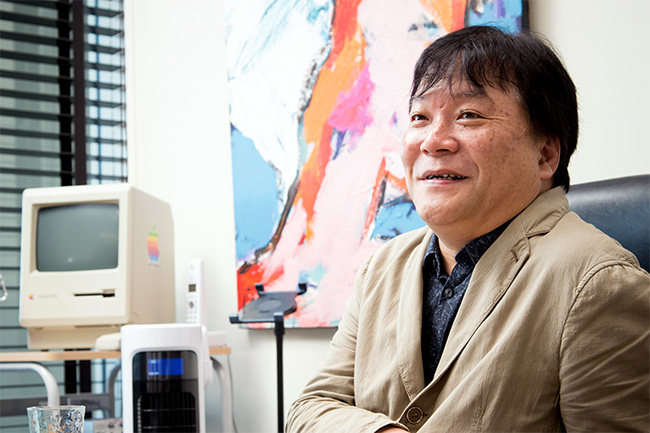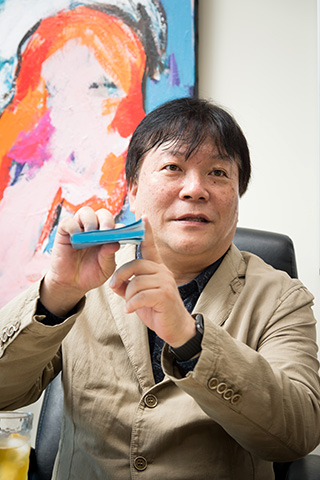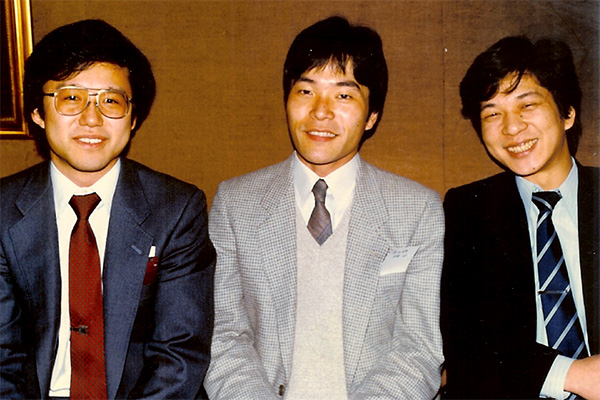- Home
- > Outreach
- > Publications
- > CONVERGENCE
- > LEADER’S VOICE
 LEADER’S VOICE
LEADER’S VOICE
A Conversation with Prof. Takuzo Aida
Pioneering New Fields with Unwavering Research Concepts

Ideas built into molecules
— I understand that you’re involved in a diverse range of research, from aqua materials to chemistry of energy conversion, supramolecular polymers and soft materials.
Actually, I’m interested in the correlation between structure and properties. Nanoscience has steadily progressed to the point where we can relatively easily realize our expected designs and functions at around the nanoscale when assembling a structure from molecules. But upward to the mesoscale, and the macroscale that is visible to the naked eye, we face many difficulties in controlling the structure, as the molecular assembly processeses don’t converge on a single structure. I’m currently seeking strategies to bridge the gap, this "missing link" between the nano world and the ordinary world.
— It’s difficult to build up structures from nano to macro size while keeping the expected structures, right?
That’s right, because there are various kinetic traps in molecular assembly at the meso and macro levels. Different multiple structures are created due to multiple kinetic traps and mixed without constituting a single entity. This means we can’t fully realize our ideas with molecules. On the other hand, human beings are made up of hierarchical and anisotropic structures that are the accumulation of molecules to the macroscale. This is enabled with certain physical perturbations of a living body. It is possible to make nanosized structures in a flask without pertubations, but quite difficult to avoid kinetic traps, the obstacle for expanding to the mesoscale and macroscale.
One successful example is the aqua material that we reported on in 2010, which is 98% water, but is free-standing and moldable. We previously adopted clay nanosheets as a component, but are now using titanium oxide nanosheets from Dr. Takayoshi Sasaki of MANA in our latest research. These titanium oxide nanosheets differ from other nanosheets in that they orientate perpendicularly to a magnetic field. This means each nanosheet can be aligned parallel to each other. Since these nanosheets have a negative charge, strong repulsion is generated between the nanosheets aligned parallel. By gelating these parallel-aligned nanosheets, we can develop a hydrogel that has anisotropic electrostatic repulsion.
We then found that this hydrogel expresses an unusual mechanical property we had never seen. If we arrange the nanosheets of the hydrogel oriented in the horizontal direction and try to compress the hydrogel orthogonally, it is highly resistive against compressive force, as the component nanosheets repel each other. This means that the gel can function as a rigid material. On the other hand, if we compress the hydrogel in the horizontal direction, it easily deforms, as the inner friction in the same direction of the nanosheets get extremely weak because of the large repulsion between the component nanosheets. This special mechanical property does not appear without an anisotropic structure carried through to the macroscale.
Actually, I’m interested in the correlation between structure and properties. Nanoscience has steadily progressed to the point where we can relatively easily realize our expected designs and functions at around the nanoscale when assembling a structure from molecules. But upward to the mesoscale, and the macroscale that is visible to the naked eye, we face many difficulties in controlling the structure, as the molecular assembly processeses don’t converge on a single structure. I’m currently seeking strategies to bridge the gap, this "missing link" between the nano world and the ordinary world.
— It’s difficult to build up structures from nano to macro size while keeping the expected structures, right?
That’s right, because there are various kinetic traps in molecular assembly at the meso and macro levels. Different multiple structures are created due to multiple kinetic traps and mixed without constituting a single entity. This means we can’t fully realize our ideas with molecules. On the other hand, human beings are made up of hierarchical and anisotropic structures that are the accumulation of molecules to the macroscale. This is enabled with certain physical perturbations of a living body. It is possible to make nanosized structures in a flask without pertubations, but quite difficult to avoid kinetic traps, the obstacle for expanding to the mesoscale and macroscale.
One successful example is the aqua material that we reported on in 2010, which is 98% water, but is free-standing and moldable. We previously adopted clay nanosheets as a component, but are now using titanium oxide nanosheets from Dr. Takayoshi Sasaki of MANA in our latest research. These titanium oxide nanosheets differ from other nanosheets in that they orientate perpendicularly to a magnetic field. This means each nanosheet can be aligned parallel to each other. Since these nanosheets have a negative charge, strong repulsion is generated between the nanosheets aligned parallel. By gelating these parallel-aligned nanosheets, we can develop a hydrogel that has anisotropic electrostatic repulsion.
We then found that this hydrogel expresses an unusual mechanical property we had never seen. If we arrange the nanosheets of the hydrogel oriented in the horizontal direction and try to compress the hydrogel orthogonally, it is highly resistive against compressive force, as the component nanosheets repel each other. This means that the gel can function as a rigid material. On the other hand, if we compress the hydrogel in the horizontal direction, it easily deforms, as the inner friction in the same direction of the nanosheets get extremely weak because of the large repulsion between the component nanosheets. This special mechanical property does not appear without an anisotropic structure carried through to the macroscale.
The importance of guiding research concepts
— What materials were you interested in originally?
I studied physical chemistry during college, but I moved to synthetic polymer chemistry in graduate school. I gained a lot of experience through work creating polymers by using catalysts. I became independent at age 37, and considered working on control of radical polymerizations as an extension of that. However, about half a year later, a research group in the U.S. published a paper about the functions of vitamin B12 in the body with exactly the same idea as mine. I took it as a sign that I should abandon continuing research based on the previous work in my field. I discussed the issue with my students and dropped it the same day. It was a turning point for me - I decided to more freely do exactly what I want to do.
My teacher, Prof. Shohei Inoue, said that the life cycle of a research project is about five years, meaning that spending too much time on a project and going into minute details isn’t particularly meaningful. I'll work at something as long as it excites me, but I try not to cling to it.
— What were the differences between your polymer research until then and synthetic chemistry?
The biggest difference was the fact that the process of creating something wasn’t important; the most important aspect was the properties and functions of the product. Synthetic chemistry attaches importance to the beauty of creation and the efficiency of the process. In materials research however, it’s important to create new properties and functions.
When I started an ERATO project sponsored by the JST (Japan Science and Technology Agency), we couldn't do any interesting research for the first two years. I had a group meeting with project members, and they said that as the director of the project I hadn’t presented a direction that they should follow. I’ve valued research concepts ever since. Deciding what molecule you should create, and deciding to do it, is the result of pursuing a research concept, which is a top-down approach.
This doesn’t mean that the concept itself gives you concrete guidelines. Physicists are concept-oriented. For example, they begin from a concept like, “Why does an apple fall from a tree?” On the other hand, chemists focus on things. While being able to make things is good, ideas tend to move in the direction of, “What shall we do with these things?” Likewise, in materials science, research to implement the known properties and functions possible with one material using a different material is uninteresting.
What’s most important is a guiding concept which provides the focal point for research. Still, I’m a chemist, so we want to design materials by ourselves as much as possible. I feel I am keeping this balance in my work.
I studied physical chemistry during college, but I moved to synthetic polymer chemistry in graduate school. I gained a lot of experience through work creating polymers by using catalysts. I became independent at age 37, and considered working on control of radical polymerizations as an extension of that. However, about half a year later, a research group in the U.S. published a paper about the functions of vitamin B12 in the body with exactly the same idea as mine. I took it as a sign that I should abandon continuing research based on the previous work in my field. I discussed the issue with my students and dropped it the same day. It was a turning point for me - I decided to more freely do exactly what I want to do.
My teacher, Prof. Shohei Inoue, said that the life cycle of a research project is about five years, meaning that spending too much time on a project and going into minute details isn’t particularly meaningful. I'll work at something as long as it excites me, but I try not to cling to it.
— What were the differences between your polymer research until then and synthetic chemistry?
The biggest difference was the fact that the process of creating something wasn’t important; the most important aspect was the properties and functions of the product. Synthetic chemistry attaches importance to the beauty of creation and the efficiency of the process. In materials research however, it’s important to create new properties and functions.
When I started an ERATO project sponsored by the JST (Japan Science and Technology Agency), we couldn't do any interesting research for the first two years. I had a group meeting with project members, and they said that as the director of the project I hadn’t presented a direction that they should follow. I’ve valued research concepts ever since. Deciding what molecule you should create, and deciding to do it, is the result of pursuing a research concept, which is a top-down approach.
This doesn’t mean that the concept itself gives you concrete guidelines. Physicists are concept-oriented. For example, they begin from a concept like, “Why does an apple fall from a tree?” On the other hand, chemists focus on things. While being able to make things is good, ideas tend to move in the direction of, “What shall we do with these things?” Likewise, in materials science, research to implement the known properties and functions possible with one material using a different material is uninteresting.
What’s most important is a guiding concept which provides the focal point for research. Still, I’m a chemist, so we want to design materials by ourselves as much as possible. I feel I am keeping this balance in my work.
Nanoarchitectonics has taken firm root around the world

— As a member of the MANA Evaluation Committee, what are your thoughts on MANA after its first ten years?
What research institutes need are distinctive, globally-competitive strengths, rather than a broad but shallow approach that dabbles in everything. When you look at conditions in Japan today, that’s a question that answers itself. In that sense, I think that MANA has established a distinctive “brand” that is really different from other research organizations.
MANA also brings together diverse human resources along the axis of materials. That structure is important. MANA is one of the world’s preeminent organizations, where outstanding researchers in different fields of specialization collaborate and work together in friendly competition as “next-door neighbors”. That kind of environment is necessary in research.
Ten years ago the word “nanoarchitectonics” had a big impact in promoting new research, but the word is now acknowledged and widely known. I have high expectations for how this base will be used moving on to the next phase in the coming years.
— MANA is engaged with basic research for the development of new materials that will support the coming age.
The most important thing for scientists involved in basic research is breaking new ground. It might be a harsh thing to say, but doing basic research in an existing field is nothing but play. I think that hints for creating a truly new research field can be often found via ideas for practical applications. If you find that a practical application of something is impossible, that’s an opportunity. Why is it impossible? Because the basis to make it possible hasn’t appeared yet. This means you have found an unseen basic research field. If you think it’s worth doing, then have the courage to do that basic research. I also work as a corporate consultant because companies often times produce seeds for important basic research. Strong, outstanding applied research can also have as remarkably high value as basic research. However, we should avoid applied research aiming at profit for business, which means that introducing “the concept of cost” to science by thinking about the economy, provision of materials, and the price of oil, among other things.
— So new research concepts can also be the product of applied research?
It’s very difficult to come up with new concepts. They might come from a conversation with a student or a consultation at a company. It’s important that you have an open mind toward things that come from outside yourself. Don’t try to fit yourself into some predetermined frame, and don’t be bound by one’s sense of values. On the other hand, if you lack persistence in your interests, you won’t be able to overcome adversities. We have to consider how and what values to adhere to and what values we should disregard. How we resolve this kind of contradiction within ourselves is a perpetual problem as a scientist.
What research institutes need are distinctive, globally-competitive strengths, rather than a broad but shallow approach that dabbles in everything. When you look at conditions in Japan today, that’s a question that answers itself. In that sense, I think that MANA has established a distinctive “brand” that is really different from other research organizations.
MANA also brings together diverse human resources along the axis of materials. That structure is important. MANA is one of the world’s preeminent organizations, where outstanding researchers in different fields of specialization collaborate and work together in friendly competition as “next-door neighbors”. That kind of environment is necessary in research.
Ten years ago the word “nanoarchitectonics” had a big impact in promoting new research, but the word is now acknowledged and widely known. I have high expectations for how this base will be used moving on to the next phase in the coming years.
— MANA is engaged with basic research for the development of new materials that will support the coming age.
The most important thing for scientists involved in basic research is breaking new ground. It might be a harsh thing to say, but doing basic research in an existing field is nothing but play. I think that hints for creating a truly new research field can be often found via ideas for practical applications. If you find that a practical application of something is impossible, that’s an opportunity. Why is it impossible? Because the basis to make it possible hasn’t appeared yet. This means you have found an unseen basic research field. If you think it’s worth doing, then have the courage to do that basic research. I also work as a corporate consultant because companies often times produce seeds for important basic research. Strong, outstanding applied research can also have as remarkably high value as basic research. However, we should avoid applied research aiming at profit for business, which means that introducing “the concept of cost” to science by thinking about the economy, provision of materials, and the price of oil, among other things.
— So new research concepts can also be the product of applied research?
It’s very difficult to come up with new concepts. They might come from a conversation with a student or a consultation at a company. It’s important that you have an open mind toward things that come from outside yourself. Don’t try to fit yourself into some predetermined frame, and don’t be bound by one’s sense of values. On the other hand, if you lack persistence in your interests, you won’t be able to overcome adversities. We have to consider how and what values to adhere to and what values we should disregard. How we resolve this kind of contradiction within ourselves is a perpetual problem as a scientist.

From the left, Prof. Atsuhi Maruyama, Tokyo Institute of Technology, Prof. Aida in his mid thirties, and Prof. Yukio Nagasaki, University of Tsukuba.
Takuzo Aida
Deputy Director, Center for Emergent Matter Science, RIKEN. Professor, Department of Chemistry and Biotechnology, School of Engineering, The University of Tokyo. Graduated from the Division of Applied Chemistry, College of Engineering, Yokohama National University in 1979. Prof. Aida completed his Doctor of Engineering degree in the Department of Applied Chemistry, School of Engineering, The University of Tokyo in 1984, and served as an Assistant in that department from 1984. He was later appointed Associate Professor of the same department, and was named Professor of the Department of Chemistry and Biotechnology, School of Engineering, The University of Tokyo in 1996. He has held his present position at RIKEN since 2013. He serves on the Review Board of the journal Science and on the Advisory Board of the Journal of the American Chemical Society. He has also received numerous awards, including the Award of the American Chemical Society in Polymer Chemistry and Award of the Chemical Society of Japan in 2009, the Fujiwara Award in 2011 and the Leo Esaki Award in 2015.
Deputy Director, Center for Emergent Matter Science, RIKEN. Professor, Department of Chemistry and Biotechnology, School of Engineering, The University of Tokyo. Graduated from the Division of Applied Chemistry, College of Engineering, Yokohama National University in 1979. Prof. Aida completed his Doctor of Engineering degree in the Department of Applied Chemistry, School of Engineering, The University of Tokyo in 1984, and served as an Assistant in that department from 1984. He was later appointed Associate Professor of the same department, and was named Professor of the Department of Chemistry and Biotechnology, School of Engineering, The University of Tokyo in 1996. He has held his present position at RIKEN since 2013. He serves on the Review Board of the journal Science and on the Advisory Board of the Journal of the American Chemical Society. He has also received numerous awards, including the Award of the American Chemical Society in Polymer Chemistry and Award of the Chemical Society of Japan in 2009, the Fujiwara Award in 2011 and the Leo Esaki Award in 2015.

